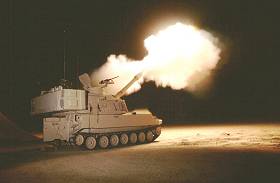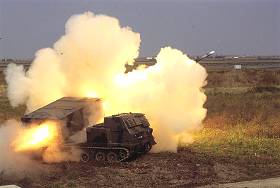





Revitalizing the artillery-close combat relationship
May 6, 2001

ometimes, how trends are perceived can be as important as the way they really are. Today's field artillery may be facing that kind of problem.
In the latest issue of ARMY, Lt. Col. Robert Leonhard, a thoughtful and experienced soldier, accuses the artillery of forsaking close support of maneuver, traditionally the artillery's defining task. Instead, he argues, close fire support has become the perhaps inadvertent victim of the field artillery's increased preoccupation with attacking targets deep in an enemy's rear.
He is not alone in thinking so. During the past few years, complaints have mounted that the close fire support on which infantry and armor units always have relied has become less responsive. For many, the field artillery seems to have imitated the Air Force, becoming more concerned with pursuing independent operations than with supporting the combined arms team.
It isn't hard to understand that complaint. The most visible post-Vietnam improvements in artillery weaponry indeed have focused on the attack of deeper targets. Counterfire radars, the Multiple Launch Rocket System, and the Army Tactical Missile System all were developed to counter threats such as enemy artillery and follow-on forces. In contrast, close support capabilities, while upgraded from time to time, have changed little in their essentials.
But Leonhard's concern and that of many of his infantry and armor colleagues has less to do with weapons than with how they are employed. From their perspective, preoccupation with deep attack has distorted fire planning and distanced artillery from maneuver. In effect, Leonhard argues, field artillery and close combat units increasingly find themselves fighting parallel but disconnected battles.
Once again, as with materiel, there is evidence to support this complaint. While artillery long has emphasized centralized management of fires, until recently the limited reach of weapons and communications routinely compelled decentralization. Maneuver brigades became accustomed to the "habitual association" of supporting artillery battalions, and fire planning largely reflected the cumulative targeting concerns of infantry and armor companies, battalions, and brigades.

As artillery's responsibilities expanded, however, so too did the costs of decentralization. Faced with supporting more and more claimants with the same limited resources, artillerymen saw little alternative but to apply greater discipline to the targeting of artillery fires. Hence, as Leonhard suggests, recent years have seen a gradual but discernible shift from bottom-up to top-down fire planning.
That process may have gone too far. Indeed, if maneuver commanders feel abandoned, it probably has. Ultimately, the key measure of artillery's success remains how quickly, cheaply, and effectively the combined arms team accomplishes its mission. A fire support system perceived as insensitive to that requirement risks failure whatever its other battlefield contributions.
To counter that perception, the artillery needs to shift the weight of development effort back to close fire support. In a materiel sense, that already is happening. Whatever one's opinion of Crusader, it clearly seeks to beef up close support of the Army's maneuver forces. So also do the lightweight howitzer program and several less visible but no less vital target acquisition and command and control improvements.
The challenge now is to match these efforts with doctrinal and organizational changes calculated to restore maneuver commanders' confidence in the field artillery's accessibility and responsiveness. One way to do that is to revisit the way artillery units are allocated among major maneuver formations.
Since World War II, with few exceptions, artillery has not been permanently assigned below division level. There once were good reasons for that, but most have long since evaporated. For practical purposes, today's brigades do what divisions once did, and the Army's transformation to a lighter, more deployable force is likely only to accelerate that devolution.
Accordingly, it's time to bite the bullet and furnish maneuver brigades organic artillery assets. Their size and composition can be debated. But however they are structured, they should furnish the brigade commander a complete kitbag of fire support tools.
In contrast, divisions, increasingly the overseers of self-contained brigades, need little or no organic field artillery for that purpose. Instead, their artillery can and should be mission-tailored from their parent corps. What the divisions need full-time isn't organic weaponry, but rather the fire planning and command and control systems to make effective use of attached artillery assets.
Such a change would go a long way toward abating the concern of maneuver commanders that they have been abandoned by their redleg colleagues. But there is a quid pro quo. Whatever the level at which field artillery units are assigned, their fires still must be understood to be a fungible asset of the force as a whole, to be applied wherever the force commander feels the need is greatest.
We need to revitalize the link between artillery and those it supports. But we also need to exploit the unique versatility artillery provides. A thoughtful re-tailoring of the artillery's doctrine and organization would do both.
Text source: Richard H. Sinnreich, The Lawton Constitution, April 27, 2001
© 2001 CheckPoint |














